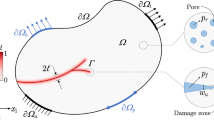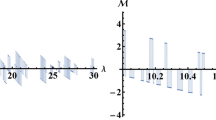Abstract
A thermodynamically consistent phase field model for crack propagation is analyzed. The thermodynamic driving force for the crack propagation is derived based on the laws of thermodynamics. The Helmholtz free energy satisfies the thermodynamic equilibrium and instability conditions for the crack propagation. Analytical solutions for the Ginzburg–Landau equation including the surface profile and the estimation of the kinetic coefficient are found. It is shown how kinetic coefficient affects the local stress field. The local critical stress for the crack propagation is calibrated with the theoretical strength which gives the value of the crack surface width. The finite element method is utilized to solve the complete system of crack phase field and mechanics equations. The analytical expressions for the crack surface profile and the crack tip velocity are verified with the numerical solutions. It is shown that under mode I cracking and proper calibration of parameters, phase field models always agree with Griffith’s theory.
Similar content being viewed by others
References
Aranson, I.S., Kalatsky, V.A., Vinokur, V.M.: Continuum field description of crack propagation. Phys. Rev. Lett. 85(1), 118–121 (2000)
Karma, A., Kessler, D.A., Levine, H.: Phase-field model of mode III dynamic fracture. Phys. Rev. Lett. 87(4), 045501 (2001)
Henry, H., Levine, H.: Dynamic instabilities of fracture under biaxial strain using a phase field model. Phys. Rev. Lett. 93(10), 105504 (2004)
Hakim, V., Karma, A.: Laws of crack motion and phase-field models of fracture. J. Mech. Phys. Solids 57(2), 342–368 (2009). https://doi.org/10.1016/j.jmps.2008.10.012
Eastgate, L., Sethna, J.P., Rauscher, M., Cretegny, T., Chen, C.-S., Myers, C.: Fracture in mode I using a conserved phase-field model. Phys. Rev. E 65(3), 036117 (2002)
Wang, Y.U., Jin, Y.M., Khachaturyan, A.G.: Phase field microelasticity theory and simulation of multiple voids and cracks in single crystals and polycrystals under applied stress. J. Appl. Phys. 91(10), 6435–6451 (2002)
Borden, M.J., Hughes, T.J.R., Landis, C.M., Verhoosel, C.V.: A higher-order phase-field model for brittle fracture: formulation and analysis within the isogeometric analysis framework. Comput. Methods Appl. Mech. Eng. 273, 100–118 (2014). https://doi.org/10.1016/j.cma.2014.01.016
Miehe, C., Hofacker, M., Welschinger, F.: A phase field model for rate-independent crack propagation: robust algorithmic implementation based on operator splits. Comput. Methods Appl. Mech. Eng. 199(45–48), 2765–2778 (2010). https://doi.org/10.1016/j.cma.2010.04.011
Ambati, M., Gerasimov, T., De Lorenzis, L.: Phase-field modeling of ductile fracture. Comput. Mech. 55(5), 1017–1040 (2015). https://doi.org/10.1007/s00466-015-1151-4
Miehe, C., Aldakheel, F., Raina, A.: Phase field modeling of ductile fracture at finite strains: a variational gradient-extended plasticity-damage theory. Int. J. Plast. 84, 1–32 (2016)
Wang, J., Zhang, T.-Y.: Phase field simulations of a permeable crack parallel to the original polarization direction in a ferroelectric mono-domain. Eng. Fract. Mech. 75(17), 4886–4897 (2008)
Nguyen, T., Yvonnet, J., Zhu, Q.-Z., Bornert, M., Chateau, C.: A phase field method to simulate crack nucleation and propagation in strongly heterogeneous materials from direct imaging of their microstructure. Eng. Fract. Mech. 139, 18–39 (2015)
Kuhn, C., Müller, R.: A continuum phase field model for fracture. Eng. Fract. Mech. 77(18), 3625–3634 (2010)
Hou, Y., Wang, L., Yue, P., Pauli, T., Sun, W.: Modeling mode I cracking failure in asphalt binder by using nonconserved phase-field model. J. Mater. Civ. Eng. 26(4), 684–691 (2013)
Levitas, V.I., Idesman, A.V., Palakala, A.K.: Phase-field modeling of fracture in liquid. J. Appl. Phys. 110(3), 033531 (2011)
Marconi, V.I., Jagla, E.A.: Diffuse interface approach to brittle fracture. Phys. Rev. E 71(3), 036110 (2005)
Voyiadjis, G.Z., Mozaffari, N.: Nonlocal damage model using the phase field method: theory and applications. Int. J. Solids Struct. 50(20), 3136–3151 (2013)
Duda, F.P., Ciarbonetti, A., Sánchez, P.J., Huespe, A.E.: A phase-field/gradient damage model for brittle fracture in elastic–plastic solids. Int. J. Plast 65, 269–296 (2015)
Levitas, V.I.: Thermodynamically consistent phase field approach to phase transformations with interface stresses. Acta Mater. 61(12), 4305–4319 (2013). https://doi.org/10.1016/j.actamat.2013.03.034
Levitas, V.I., Lee, D.-W., Preston, D.L.: Interface propagation and microstructure evolution in phase field models of stress-induced martensitic phase transformations. Int. J. Plast. 26(3), 395–422 (2010). https://doi.org/10.1016/j.ijplas.2009.08.003
Levitas, V.I., Javanbakht, M.: Surface tension and energy in multivariant martensitic transformations: phase-field theory, simulations, and model of coherent interface. Phys. Rev. Lett. 105(16), 165701 (2010)
Levitas, V.I., Javanbakht, M.: Surface-induced phase transformations: multiple scale and mechanics effects and morphological transitions. Phys. Rev. Lett. 107(17), 175701 (2011)
Javanbakht, M., Levitas, V.I.: Interaction between phase transformations and dislocations at the nanoscale. Part 2: phase field simulation examples. J. Mech. Phys. Solids 82, 164–185 (2015)
Levitas, V.I., Javanbakht, M.: Interaction between phase transformations and dislocations at the nanoscale. Part 1. General phase field approach. J. Mech. Phys. Solids 82, 287–319 (2015). https://doi.org/10.1016/j.jmps.2015.05.005
Javanbakht, M., Levitas, V.I.: Phase field simulations of plastic strain-induced phase transformations under high pressure and large shear. Phys. Rev. B 94(21), 214104 (2016)
Javanbakht, M., Levitas, V.I.: Nanoscale mechanisms for high-pressure mechanochemistry: a phase field study. J. Mater. Sci. (2018). https://doi.org/10.1007/s10853-018-2175-x
Javanbakht, M., Barati, E.: Martensitic phase transformations in shape memory alloy: phase field modeling with surface tension effect. Comput. Mater. Sci. 115, 137–144 (2016). https://doi.org/10.1016/j.commatsci.2015.10.037
Li, W., Landis, C.M.: Nucleation and growth of domains near crack tips in single crystal ferroelectrics. Eng. Fract. Mech. 78(7), 1505–1513 (2011). https://doi.org/10.1016/j.engfracmech.2011.01.002
Zhao, T., Zhu, J., Luo, J.: Study of crack propagation behavior in single crystalline tetragonal zirconia with the phase field method. Eng. Fract. Mech. (2016). https://doi.org/10.1016/j.engfracmech.2016.03.035
Provatas, N., Elder, K.: Phase-Field Methods in Materials Science and Engineering. Wiley, New York (2011)
Francfort, G.A., Marigo, J.J.: Revisiting brittle fracture as an energy minimization problem. J. Mech. Phys. Solids 46(8), 1319–1342 (1998). https://doi.org/10.1016/S0022-5096(98)00034-9
Bourdin, B., Francfort, G.A., Marigo, J.J.: Numerical experiments in revisited brittle fracture. J. Mech. Phys. Solids 48(4), 797–826 (2000). https://doi.org/10.1016/S0022-5096(99)00028-9
Amor, H., Marigo, J.-J., Maurini, C.: Regularized formulation of the variational brittle fracture with unilateral contact: numerical experiments. J. Mech. Phys. Solids 57(8), 1209–1229 (2009)
Patil, S.P., Heider, Y., Hernandez Padilla, C.A., Cruz-Chú, E.R., Markert, B.: A comparative molecular dynamics-phase-field modeling approach to brittle fracture. Comput. Methods Appl. Mech. Eng. (2016). https://doi.org/10.1016/j.cma.2016.04.005
dell’Isola, F., Seppecher, P., Madeo, A.: How contact interactions may depend on the shape of Cauchy cuts in Nth gradient continua: approach “à la D’Alembert”. Zeitschrift für angewandte Mathematik und Physik 63(6), 1119–1141 (2012). https://doi.org/10.1007/s00033-012-0197-9
Rinaldi, A., Placidi, L.: A microscale second gradient approximation of the damage parameter of quasi-brittle heterogeneous lattices. ZAMM J. Appl. Math. Mech./Zeitschrift für Angewandte Mathematik und Mechanik 94(10), 862–877 (2014). https://doi.org/10.1002/zamm.201300028
dell’Isola, F., Andreaus, U., Placidi, L.: At the origins and in the vanguard of peridynamics, non-local and higher-gradient continuum mechanics: an underestimated and still topical contribution of Gabrio Piola. Math. Mech. Solids 20(8), 887–928 (2015). https://doi.org/10.1177/1081286513509811
dell’Isola, F., Seppecher, P., Corte, A.D.: The postulations á la D’Alembert and á la Cauchy for higher gradient continuum theories are equivalent: a review of existing results. Proc. R. Soc. A Math. Phys. Eng. Sci. 471(2183), 20150415 (2015). https://doi.org/10.1098/rspa.2015.0415
Placidi, L.: A variational approach for a nonlinear 1-dimensional second gradient continuum damage model. Continuum Mech. Thermodyn. 27(4), 623–638 (2015). https://doi.org/10.1007/s00161-014-0338-9
dell’Isola, F., Corte, A.D., Giorgio, I.: Higher-gradient continua: the legacy of Piola, Mindlin, Sedov and Toupin and some future research perspectives. Math. Mech. Solids 22(4), 852–872 (2017). https://doi.org/10.1177/1081286515616034
Placidi, L., Barchiesi, E.: Energy approach to brittle fracture in strain-gradient modelling. Proc. R. Soc. A Math. Phys. Eng. Sci. (2018). https://doi.org/10.1098/rspa.2017.0878
Placidi, L., Misra, A., Barchiesi, E.: Two-dimensional strain gradient damage modeling: a variational approach. Zeitschrift für angewandte Mathematik und Physik 69(3), 56 (2018). https://doi.org/10.1007/s00033-018-0947-4
Miehe, C., Welschinger, F., Hofacker, M.: Thermodynamically consistent phase-field models of fracture: variational principles and multi-field FE implementations. Int. J. Numer. Meth. Eng. 83(10), 1273–1311 (2010)
Porter, D.A., Easterling, K.E., Sherif, M.: Phase Transformations in Metals and Alloys, (Revised Reprint). CRC Press, Boca Raton (2009)
Yue, P., Zhou, C., Feng, J.J.: Sharp-interface limit of the Cahn–Hilliard model for moving contact lines. J. Fluid Mech. 645, 279–294 (2010). https://doi.org/10.1017/S0022112009992679
Boullay, P., Schryvers, D., Ball, J.: Nano-structures at martensite macrotwin interfaces in Ni 65 Al 35. Acta Mater. 51(5), 1421–1436 (2003)
Krausz, A.S.: Fracture Kinetics of Crack Growth, vol. 1. Springer, Berlin (2012)
Author information
Authors and Affiliations
Corresponding author
Additional information
Communicated by Francesco dell’Isola.
Publisher's Note
Springer Nature remains neutral with regard to jurisdictional claims in published maps and institutional affiliations.
Rights and permissions
About this article
Cite this article
Farrahi, G.H., Javanbakht, M. & Jafarzadeh, H. On the phase field modeling of crack growth and analytical treatment on the parameters. Continuum Mech. Thermodyn. 32, 589–606 (2020). https://doi.org/10.1007/s00161-018-0685-z
Received:
Accepted:
Published:
Issue Date:
DOI: https://doi.org/10.1007/s00161-018-0685-z




